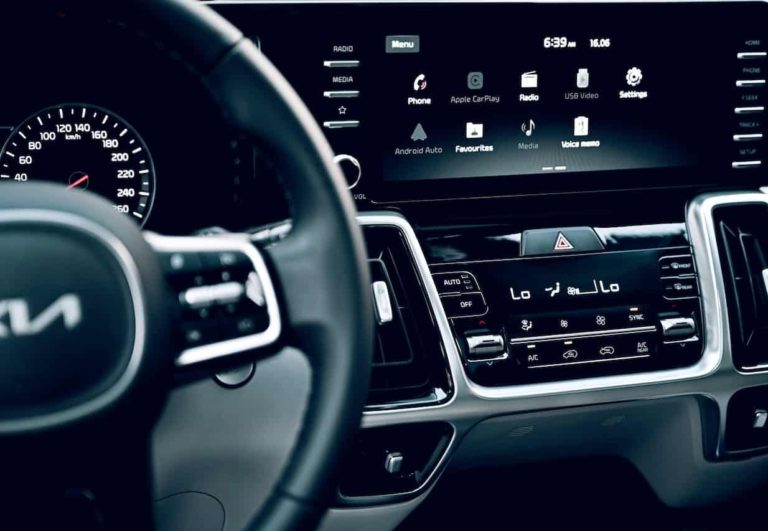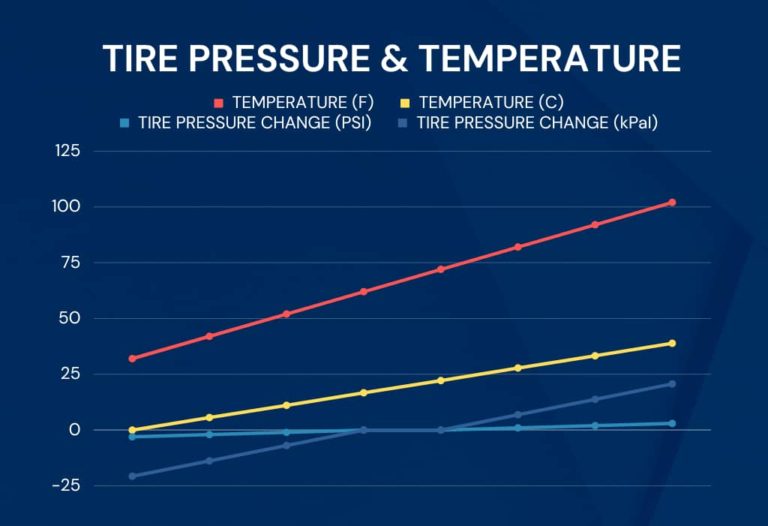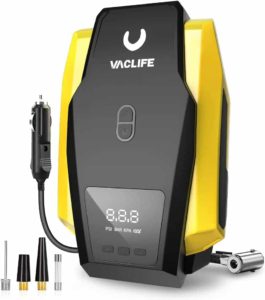What is the TPMS in a Kia Forte?
The Kia Forte tire pressure monitoring system, also known as TPMS, is an underrated safety feature designed to keep you informed about the health of your tires. This sophisticated technology constantly monitors the air pressure within your vehicle’s tires and alerts you via a dashboard light if the pressure gets too low. By providing live pressure data, the TPMS ensures you maintain optimal tire pressure, contributing to better fuel efficiency, prolonged tire lifespan, and most importantly, a safer driving experience. To check your tire pressure: press the mode button on your steering wheel and scroll over to the information mode to see your current pressures. Or use an accurate digital tire pressure gauge. The Kia Forte tire pressures are below.
Kia Forte Tire Pressure
Tire Size | FRONT PSI | REAR PSI |
195/65R15 | 33 | 33 |
205/55R16 | 33 | 33 |
225/40R18 | 35 | 35 |
225/45R17 | 35 | 35 |
SPARE TIRE | 60 | 60 |
Steps to Reset Kia Forte Low Tire Pressure Light
The Kia Forte does not have a tire pressure reset button.
When the tire pressure light on the dashboard lights up, pull over and check your tire pressure right away.
Determine which tire is causing the tire pressure light to turn on and adjust the tire pressure accordingly.
Fill your tire to the exact recommended pressures. I cannot emphasize this enough, accuracy is key.
Drive your Kia Forte. Drive for a few minutes at speeds over 20 Mph.
If the light doesn’t go off right away, re-check your tire pressure to make sure they are all at the exact pressure you set them to. If they are down in pressure, you probably have some sort of tire leak.
If the pressures are at the exact pressure you set them to and the tire light still won’t go off, over fill your tires.
We recommend filling your problem tire with 45 Psi or about 10 Psi over the recommended pressure. With the tire overfilled, drive the car again for 10 or 15 minutes. This will turn off the tire light.
Now that the tire light is off, readjust the pressure back to the recommended pressure.
How Does the Kia Forte TPMS Work?
Sensors: The Kia Forte’s tire pressure system has sensors mounted on the end of each valve stem to measure air pressure and temperature of each tire.
Wireless data transmission: The sensors wirelessly transmit the tire pressure data to the car’s TPMS control unit and ECU/ECM using radio frequencies.
Continuous monitoring: The TPMS control unit continually analyzes and measures the tire pressure data received from the sensors.
Pressure comparison: The system compares the measured tire pressure against the recommended levels set by Kia for the Forte.
Warning activation: If the measured tire pressure is below the recommended levels, the TPMS triggers a warning.
Dashboard display: The TPMS warning light appears on the dashboard LCD with a yellow exclamation point.
Tire identification: The Kia Forte’s tire pressure system indicates which specific tire is experiencing a pressure issue.
Regular monitoring: The TPMS continuously monitors and measures your tire pressure while driving.
What is the TPMS Malfunction Indicator?
Your Kia Forte also has a special warning light to alert you to potential issues with your tire pressure monitoring system (TPMS). This warning light displays flashing yellow exclamation point, identical to the tire warning light. If there is a problem with the TPMS, the light will flash for about 60 seconds before staying on. This sequence will occur every time you start your car until the issue is resolved. So, when your tire light is flashing or blinking, the system will not be able to accurately detect low tire pressure. In conclusion, a blinking tire pressure light means there is a malfunction within the TPMS itself, rather than an actual tire pressure issue. Often, this is due to a defective pressure sensor in one of your tires. To determine which sensor is faulty, use a TPMS diagnostic tool.
What Causes the Low Tire Pressure Light to Turn On?
Temperature changes: A drop in ambient temperature can cause tire pressure to decrease, triggering the warning light.
Tire puncture or leak: A sharp object like a nail or screw may puncture a tire, causing significant air loss which will of course activate the warning light.
Faulty tire pressure sensor: Damaged or malfunctioning sensors may provide inaccurate readings, resulting in a false alert. The only way to determine which sensor is faulty is to scan each sensor with a TPMS diagnostic tool.
Valve stem issues: A damaged or leaking valve stem can lead to gradual pressure loss and eventually activate the tire pressure light. There are kits to replace the rubber gasket that usually goes bad.
Tire damage: Impact from potholes or hitting a curb can cause structural damage like tire bubbles, leading to pressure loss.
Sensor battery life: TPMS sensors are battery-powered, and over time, batteries die. (they usually last anywhere from 5-10 years) This will cause the tire pressure light to turn on. Again, you must use a diagnostic tool to determine which sensor is dead or dying. Sensor batteries are not replaceable, you must replace the entire sensor.
Recent tire rotation or replacement: If the tires have been recently rotated or replaced, the TPMS may need recalibration to avoid false alerts. Sometimes the vehicle’s computer may think the front tires are in the rear and rear in the front after a rotation.
Wheel or rim issues: Damaged, corroded, or cracked wheels or rims can lead to air leaks and pressure loss. This is very common with low profile tires.
New Wheel or Rims: If you replace a wheel or rim and don’t swap over the old tire pressure sensor to the new wheel or rim, your tire light will remain on.
Spare Tire: If you are driving with a spare tire on your Kia Forte, the tire light will stay on until you put the wheel with the sensor back on the car.
Altitude changes: Climbing or descending in elevation can affect tire pressure and trigger the TPMS warning.
Natural pressure loss: Tires lose air pressure over time due to temperature changes and permeation. Tire dry-rot will happen to tires that sit for long periods of time.
Inconsistent Tire pressure: If the tires on your vehicle have significantly different pressures, it could trigger the warning light.
Mismatched Tires: If your vehicle’s tires are not all the same size or type, the TPMS may incorrectly register a pressure problem.
Electrical problems or software issues within the car’s TPMS system. Occasionally the system may have a software update.
What Happens to Underinflated Tires?
When the tires on your Kia Forte are underinflated, it means there’s not enough air pressure inside them to support the vehicle’s weight and performance demands. This lack of pressure poses several risks and challenges. First, underinflation can lead to increased tire wear because it causes the tires to flatten out and have more surface area in contact with the road. This results in the tires heating up more than they should, which can speed up tire degradation and even lead to a blowout if left unchecked. Additionally, underinflated tires can negatively impact your car’s handling and stability, making it harder to steer especially at high speeds, in sharp turns, or emergency situations. It also reduces braking efficiency, potentially increasing your stopping distances. Finally, underinflated tires can lower your vehicle’s fuel efficiency because they create more rolling resistance. This means your car’s engine has to work harder to keep the car moving.
How Does Weather Affect Tire Pressure?
Weather plays a surprisingly pivotal role in your Kia Forte’s tire pressure. Here’s why: air expands when it’s heated and contracts when it’s cooled. So, in hot weather the air inside your tires will expand which leads to an increase in tire pressure. Conversely, in colder weather the air contracts, which causes the tire pressure to drop. This is why you might see your tire pressure warning light illuminate on a particularly cold morning. For every 10 degrees Fahrenheit change in temperature, your tire’s pressure can change about 1-2 PSI. So remember, regular tire pressure checks are crucial, especially when the seasons change.
How to Adjust Your Tire Pressure?
Get a high-quality tire gauge.
Make sure to check the tire pressure when the tires are cold. “Cold” means your vehicle has been idle for at least three hours or driven less than 1 mile.
Take off the valve cap from the tire valve stem.
Push the tire gauge firmly onto the valve to measure the pressure.
Compare the pressure reading with the recommended pressure on the tire information label.
If the pressure is lower than the recommended pressure, add air.
If the pressure is too high, let out some air by pressing the metal stem in the center of the tire valve. You can use any object like a screwdriver to do this. Be gentle.
Recheck the tire pressure with the gauge.
Don’t forget to put the valve caps back on to prevent leaks and keep dirt and moisture out.
When Should You Adjust Your Tire Pressure?
The optimal time to adjust your Kia Forte’s tire pressure is in the morning or when your vehicle has been parked sitting for a few hours. This is because your tires need to be cold when you’re checking and adjusting the pressure for accurate readings. When you drive, the tires heat up, which can cause the air inside to expand and give a higher pressure reading. Do not adjust your tire pressure when your tires are hot, it will not be accurate and can lead to overinflation issues!
What are the Benefits of the Tire Pressure Monitoring System?
We know when the tire light comes on it’s annoying, but it has many benefits!
Safety: By alerting you of underinflated or overinflated tires, the TPMS helps prevent tire blowouts and other dangerous situations that could arise from improperly inflated tires.
Efficiency: Proper tire pressure contributes to better fuel economy. With your TPMS, you can ensure your tires are optimally inflated to get the best mileage out of your Kia Forte.
Tire Lifespan: TPMS helps prolong the lifespan of your tires by encouraging proper tire pressure maintenance, which reduces uneven or premature tread wear.
Performance: Correct tire pressure is crucial for optimal vehicle handling and braking. TPMS helps maintain this, ensuring your vehicle performs at its best.
Convenience: Checking tire pressure manually can be time-consuming and inconvenient. TPMS automates this process, providing constant real-time updates and alerts, saving you time and effort.
Cost Savings: By helping to improve fuel efficiency and extend tire life, the TPMS can save you money in the long run on fuel and tire replacement costs.
Conclusion
So there you have it – an in-depth guide to your Kia Forte’s tire pressure monitoring system. As you can see, this feature is more than just a fancy gadget. It’s a safety, performance, and efficiency enhancer that plays a vital role in your car’s overall operation. It helps ensure your tires are in optimal condition, aiding in fuel efficiency, extending the lifespan of your tires, and most importantly, keeping you safe on the road. While it might seem like a nuisance when that tire pressure light illuminates, remember it’s doing a crucial job! So, stay aware, stay informed, and keep on top of your tire pressure. Happy driving! Everything in this article is applicable to all Kia Forte models and trims.
Please note that this blog post contains Amazon affiliate links. This means that if you make a purchase through one of these links, we at TPMSRESET.com may earn a small commission at no extra cost to you. We only recommend products that we personally use and believe in. Thank you for supporting us.




